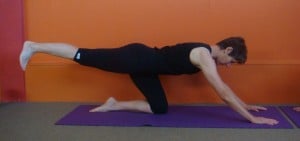The Key Fundamental Pelvic Patterns and their use in yoga therapy
Running courses is a way of sharing some of the knowledge I have gathered about the human body and how to prevent and rectify dysfunction. I am often surprised to see other movement or health practitioners, including physiotherapists, as clients in my practice. … Read More
Hamstring problems: what’s the cause?
Why are ‘hamstring problems’ so common? They are a huge burden in the sports industry, but can also afflict the rest of us – both the ‘weekend warrior’ and ‘couch potato’ alike. Various ‘diagnoses’ are attributed to an array of … Read More
Retraining the core
Training the core – what is it and what isn’t it? The modern concept of core retraining emerged following Hodges research which showed delayed activity of the deep ‘core muscles’ in people with back pain. With this came the boom of the … Read More
‘Butt clenching’ and ‘tail tucking’ and its link to back pain
‘Butt clenching’ and ‘tail tucking’ are generally habitual motor responses resulting from an instruction to tighten the gluts or squeeze the butt as part of an exercise programme. Or, for others it’s simply an adaptive posture. The problem is that … Read More
Importance of retraining functional movement
There is a lack of consensus as to what is the appropriate exercise therapy in the management of low back pain and pelvic disorders. The division is over whether to engage in specific motor re-learning activities, that include ‘core’ activation or … Read More
A different take on tendinopathies: What can qualitative clinical evidence tell us in the case of lower limb tendinopathies?
I’d like to share further insights gleaned from clinical practice, informed by the evidence – and offer a bit of paradigm shift in the way we approach and manage tendinopathies. Here is a précis of my presentation at the recent … Read More
Looking at ‘neutral spine’
The spine is an integrated movement system, changes in one part of the spine affect the rest of the spine. The spine consists of four physiological curves that determine the functionality of the spine and myo-fascial system – two … Read More
How healthy is your breathing pattern?
Breathing is critical to activating the deep inner unit or ‘core’. This exercise is about observing your own breath, recognising your pattern of breathing and how this affects your spinal health. By understanding your own breathing patterns you will be … Read More
Exercise programs suitable for people with back pain
Spinal pain research demonstrates the importance of the deep sensori-motor system in healthy postural and movement control of the trunk. When this deep muscle system is lazy and weak, the body compensates by over-engaging some of the large more superficial … Read More
Revisiting ‘a neutral spine’ – and why does it matter?
A ‘neutral spine’ is deemed important – but it’s frequently only paid lip-service in clinical practice Are you clear what ‘a neutral spine’ means – and why it matters? The natural ’neutral’ spinal column has four curves when viewed in … Read More
Sitting posture: what’s usual? – what’s ideal?
In ‘ideal’ sitting, the lumbo-pelvic spine is in the ‘neutral’ lordotic curve – the entire spine is supported upright against gravity in its natural curves. Unfortunately this is not usual. Sitting with ‘poise’ is a fast dying habit – and … Read More
Do stretches and strengthening exercises perpetuate our client’s problem?
As physical therapists the profession has largely moved away from hands-on treatment and are handing out exercises as though our clients are kids in a lolly store. But, could the exercises prescribed be contributing to their problem? Most musculoskeletal problems are … Read More
How ‘therapeutic’ are the exercises that you prescribe for your clients with musculoskeletal pain?
It’s interesting to reflect on why so many people are suffering from back pain and other ‘injuries’ these days. It’s not just the elite athletes, but also the ‘weekend warriors’, those trying to be fit and trim at the gym … Read More
Stability versus core – why are clinicians not seeing results?
No one concept has been so misunderstood confused and abused as that of ‘core control’. Fixing and bracing does not equate with movement control, nor does activation of transversus abdominus alone. I am continually perplexed by the number of clients … Read More
Sports injuries and tendinopathies around the pelvis and hip should be easy to fix – why are they causing such a problem?
Differentiating between the numerous pain syndromes that commonly occur around the pelvis and hip and arriving at a sound diagnosis can be a tricky. Misdiagnosis is common. Increasingly apparent are the sporting ‘injuries’ and so called ‘over-use syndromes’- gluteal and … Read More
How do you choose valuable continued professional development?
With the plethora of continuing professional development workshops crowding the treatment profession, what makes a workshop worth attending and how do you know your dollars are being invested wisely? One of the many things I have learnt in my 40 … Read More
Pre-natal exercise for expecting mothers
Although pregnancy changes the centre of gravity, it should not change our thinking about the position of the pelvis or the need to maintain the fundamental patterns of movement.
The key role of the sacrum in healthy movement control and pain free performance
It is apparent to me that there is some confusion about sacroiliac joint (SIJ) function. On one hand some practitioners consider that the SIJ does not move – while at the other end of the spectrum, others adhere to the concept of a potentially vulnerable structure – an ‘unstable pelvis’ or one that ‘has slipped out’. Clinical evidence shows that the truth lies somewhere in between – it does move, but it doesn’t slip out. It’s more a case of directional strain that causes pain.
The Fundamental Shoulder Patterns
Most of us suffer from some stiffness in the neck and shoulders and ‘rotator cuff’ problems are becoming very common. Poor control of the shoulder girdle is always a problem. Try to get into the habit of doing these simple … Read More
Don’t underestimate the thorax when treating neck pain
Successful treatment of neck pain also involves addressing the dysfunction in the thorax and shoulder girdle
The latest LBP and Pelvic pain research – a review of the 8th Interdisciplinary World Congress on Low Back and Pelvic Pain, Dubai, October 2013
Get the low-down on the latest research into LBP and Pelvic pain – fascia; neuroplasticity and motor control; clinical subgrouping; breathing
Slump-sitting: Why choose to give yourself problems?
HOW we sit is important for musculoskeletal health and general well-being. Slumping switches off your ‘core’ and is directly linked to pelvic and spinal pain.
Strengthening ‘the glutes’: helpful or harmful?
With increasing importance placed on ‘strengthening the glutes’, the hunt for ‘the best glute exercises’ is evident.
‘Core’ matters
Understanding the real role of ‘the core’ and how to properly retrain its function is important in ‘injury’ prevention and rehabilitation.
Re-examining the ‘bio’ in a biopsychosocial approach to the management of pain
In the biopsychosocial model the ‘bio’ aspect risks being a poor relation to the psychosocial. How well do we understand and deal with it?
Axial dysfunction: Are you missing the real criminal driving many ‘Central Sensitisation’ and/or ‘Peripheral Pain’ syndromes?
Better understand spino-pelvic dysfunction and you’ll help a lot more of your patients
Reflecting upon the 3rd International Fascia Conference
Structural and functional importance of the fascial system. Discover how chronic low load repetitive motions are associated with peripheral inflammation and cortical change.
We’re online!
Dear colleagues, I’d like to let you know about my new website, which has been created for the benefit of clinicians. Here, I will be sharing some of the clinical knowledge that I have gleaned over many years of clinical practice. I … Read More



























